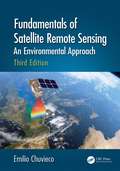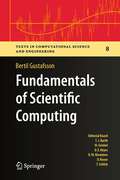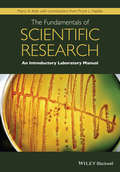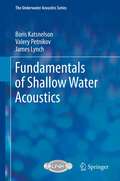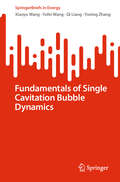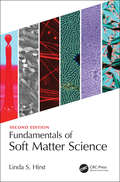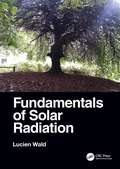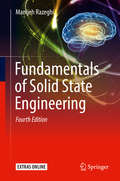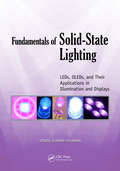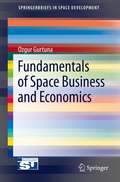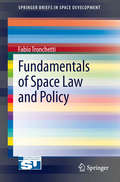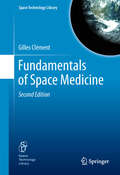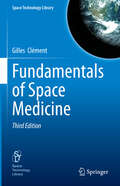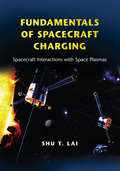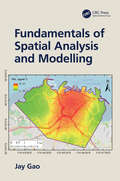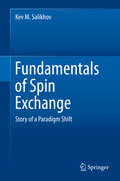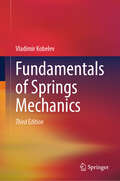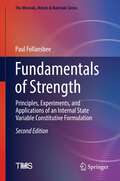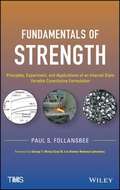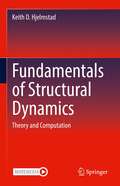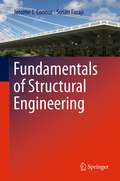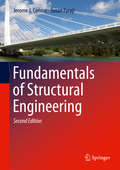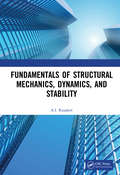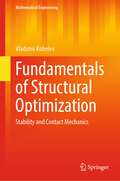- Table View
- List View
Fundamentals of Satellite Remote Sensing: An Environmental Approach, Third Edition
by Emilio ChuviecoFundamentals of Satellite Remote Sensing: An Environmental Approach, Third Edition, is a definitive guide to remote sensing systems that focuses on satellite-based remote sensing tools and methods for space-based Earth observation (EO). It presents the advantages of using remote sensing data for studying and monitoring the planet, and emphasizes concepts that make the best use of satellite data. The book begins with an introduction to the basic processes that ensure the acquisition of space-borne imagery, and provides an overview of the main satellite observation systems. It then describes visual and digital image analysis, highlights various interpretation techniques, and outlines their applications to science and management. The latter part of the book covers the integration of remote sensing with Geographic Information System (GIS) for environmental analysis. This latest edition has been written to reflect a global audience and covers the most recent advances incorporated since the publication of the previous book, relating to the acquisition and interpretation of remotely sensed data. New in the Third Edition: Includes additional illustrations in full color. Uses sample images acquired from different ecosystems at different spatial resolutions to illustrate different interpretation techniques. Includes updated EO missions, such as the third generations of geostationary meteorological satellites, the new polar orbiting platforms (Suomi), the ESA Sentinels program, and high-resolution commercial systems. Includes extended coverage of radar and LIDAR processing methods. Includes all new information on near-ground missions, including unmanned aerial vehicles (UAVs). Covers new ground sensors, as well as machine-learning approaches to classification. Adds more focus on land surface characterization, time series, change detection, and ecosystem processes. Extends the interactions of EO data and GIS that cover different environmental problems, with particular relevance to global observation. Fundamentals of Satellite Remote Sensing: An Environmental Approach, Third Edition, details the tools that provide global, recurrent, and comprehensive views of the processes affecting the Earth. As one of CRC’s Essential titles, this book and stands out as one of the best in its field and is a must-have for researchers, academics, students, and professionals involved in the field of environmental science, as well as for libraries developing collections on the forefront of this industry.
Fundamentals of Scientific Computing
by Bertil GustafssonThe book of nature is written in the language of mathematics -- Galileo Galilei How is it possible to predict weather patterns for tomorrow, with access solely to today's weather data? And how is it possible to predict the aerodynamic behavior of an aircraft that has yet to be built? The answer is computer simulations based on mathematical models - sets of equations - that describe the underlying physical properties. However, these equations are usually much too complicated to solve, either by the smartest mathematician or the largest supercomputer. This problem is overcome by constructing an approximation: a numerical model with a simpler structure can be translated into a program that tells the computer how to carry out the simulation. This book conveys the fundamentals of mathematical models, numerical methods and algorithms. Opening with a tutorial on mathematical models and analysis, it proceeds to introduce the most important classes of numerical methods, with finite element, finite difference and spectral methods as central tools. The concluding section describes applications in physics and engineering, including wave propagation, heat conduction and fluid dynamics. Also covered are the principles of computers and programming, including MATLAB®.
The Fundamentals of Scientific Research
by Marcy A. Kelly Pryce L. HaddixThe Fundamentals of Scientific Research: An Introductory Laboratory Manual is a laboratory manual geared towards first semester undergraduates enrolled in general biology courses focusing on cell biology. This laboratory curriculum centers on studying a single organism throughout the entire semester - Serratia marcescens, or S. marcescens, a bacterium unique in its production of the red pigment prodigiosin. The manual separates the laboratory course into two separate modules. The first module familiarizes students with the organism and lab equipment by performing growth curves, Lowry protein assays, quantifying prodigiosin and ATP production, and by performing complementation studies to understand the biochemical pathway responsible for prodigiosin production. Students learn to use Microsoft Excel to prepare and present data in graphical format, and how to calculate their data into meaningful numbers that can be compared across experiments. The second module requires that the students employ UV mutagenesis to generate hyper-pigmented mutants of S. marcescens for further characterization. Students use experimental data and protocols learned in the first module to help them develop their own hypotheses, experimental protocols, and to analyze their own data. Before each lab, students are required to answer questions designed to probe their understanding of required pre-laboratory reading materials. Questions also guide the students through the development of hypotheses and predictions. Following each laboratory, students then answer a series of post-laboratory questions to guide them through the presentation and analysis of their data, and how to place their data into the context of primary literature. Students are also asked to review their initial hypotheses and predictions to determine if their conclusions are supportive. A formal laboratory report is also to be completed after each module, in a format similar to that of primary scientific literature. The Fundamentals of Scientific Research: An Introductory Laboratory Manual is an invaluable resource to undergraduates majoring in the life sciences.
Fundamentals of Shallow Water Acoustics
by James Lynch Boris Katsnelson Valery PetnikovShallow water acoustics (SWA), the study of how low and medium frequency sound propagates and scatters on the continental shelves of the worlds oceans, has both technical interest and a large number of practical applications. Technically, shallow water poses an interesting medium for the study of acoustic scattering, inverse theory, and propagation physics in a complicated oceanic waveguide. Practically, shallow water acoustics has interest for geophysical exploration, marine mammal studies, and naval applications. Additionally, one notes the very interdisciplinary nature of shallow water acoustics, including acoustical physics, physical oceanography, marine geology, and marine biology. In this specialized volume the authors, all of whom have extensive at-sea experience in US and Russian research efforts, have tried to summarize the main experimental, theoretical, and computational results in shallow water acoustics, with an emphasis on providing physical insight into the topics presented.
Fundamentals of Single Cavitation Bubble Dynamics (SpringerBriefs in Energy)
by Xiaoyu Wang Yufei Wang Qi Liang Yuning ZhangThis brief provides a comprehensive review of the rapidly expanding field of cavitation and bubble dynamics, covering the discussion of bubble dynamics equations, bubble oscillation dynamics, theoretical prediction models of jets, and high-speed photography technology. Among them, the core formulas, important research methods, and typical results related to bubble oscillation and collapse dynamics are systematically and comprehensively introduced. Specifically, in terms of the bubble dynamics equations, several classical dynamic equations utilized to describe the radial motion of the spherical bubble, cylindrical bubble, and the bubble in a droplet are derived and compared. In terms of the bubble oscillation dynamics, based on the perturbation method, multi-scale method, and Laplace transform method, the nonlinear oscillation characteristics of the bubble in free oscillation and driven oscillation are analyzed. In terms of the jet prediction theory, the Kelvin impulse model and various boundary treatment methods are given in detail, and the jet direction, intensity, and spatial sensitivity caused by the bubble collapse near various boundaries are discussed. In terms of the bubble collapse visualization based on the high-speed photography, taking the laser-induced bubble as an example, the system composition, operation process and experimental layout of the high-speed photography experimental platform are introduced, and a large number of typical bubble collapse deformation, jet evolution and shock wave propagation characteristics obtained from experiments are demonstrated. This book is intended for academic researchers and graduate students in fluid dynamics, aiming to consolidate the basic theory, physical mechanism, and latest progress in the field of bubble dynamics.
Fundamentals of Soft Matter Science
by Linda S. HirstThis revised edition continues to provide the most approachable introduction to the structure, characteristics, and everyday applications of soft matter. It begins with a substantially revised overview of the underlying physics and chemistry common to soft materials. Subsequent chapters comprehensively address the different classes of soft materials, from liquid crystals to surfactants, polymers, colloids, and biomaterials, with vivid, full-color illustrations throughout. There are new worked examples throughout, new problems, some deeper mathematical treatment, and new sections on key topics such as diffusion, active matter, liquid crystal defects, surfactant phases and more. • Introduces the science of soft materials, experimental methods used in their study, and wide-ranging applications in everyday life. • Provides brand new worked examples throughout, in addition to expanded chapter problem sets and an updated glossary. • Includes expanded mathematical content and substantially revised introductory chapters. This book will provide a comprehensive introductory resource to both undergraduate and graduate students discovering soft materials for the first time and is aimed at students with an introductory college background in physics, chemistry or materials science.
Fundamentals of Solar Cell Design
by Inamuddin Mohd Imran Ahamed Rajender Boddula Mashallah RezakazemiSolar cells are semiconductor devices that convert light photons into electricity in photovoltaic energy conversion and can help to overcome the global energy crisis. Solar cells have many applications including remote area power systems, earth-orbiting satellites, wristwatches, water pumping, photodetectors and remote radiotelephones. Solar cell technology is economically feasible for commercial-scale power generation. While commercial solar cells exhibit good performance and stability, still researchers are looking at many ways to improve the performance and cost of solar cells via modulating the fundamental properties of semiconductors. Solar cell technology is the key to a clean energy future. Solar cells directly harvest energy from the sun’s light radiation into electricity are in an ever-growing demand for future global energy production. Solar cell-based energy harvesting has attracted worldwide attention for their notable features, such as cheap renewable technology, scalable, lightweight, flexibility, versatility, no greenhouse gas emission, environment, and economy friendly and operational costs are quite low compared to other forms of power generation. Thus, solar cell technology is at the forefront of renewable energy technologies which are used in telecommunications, power plants, small devices to satellites. Aiming at large-scale implementation can be manipulated by various types used in solar cell design and exploration of new materials towards improving performance and reducing cost. Therefore, in-depth knowledge about solar cell design is fundamental for those who wish to apply this knowledge and understanding in industries and academics. This book provides a comprehensive overview on solar cells and explores the history to evolution and present scenarios of solar cell design, classification, properties, various semiconductor materials, thin films, wafer-scale, transparent solar cells, and so on. It also includes solar cells’ characterization analytical tools, theoretical modeling, practices to enhance conversion efficiencies, applications and patents.
Fundamentals of Solar Radiation
by Lucien WaldThe sun radiates a tremendous amount of energy, called solar energy or solar radiation, which is the main natural source of energy on the Earth, by far. Because solar radiation is the almost unique supplier of energy to the Earth, it has a primary influence on life and activities on the Earth. The climate is a first example, but there are many others, such as plant growth or human health, or even the design of buildings, the production of energy, notably electrical and thermal, or even aging materials. This book aims to provide simple answers to anyone who has questions about solar radiation. Its ambition is to help by presenting the fundamental elements of the solar radiation received on the ground. The book includes many examples and numerous illustrations, as well as some simple but fairly precise equations to calculate the various elements covered and to reproduce the figures and graphs. The first of the three parts of this book is devoted to the relative geometry between the direction of the sun and an observer on the ground as well as to the solar radiation emitted by the sun and received at the top of the atmosphere. The orbit of the Earth around the sun and the solar declination are described. The concept of time is introduced which is closely linked to the solar cycle and the rotation of the Earth on itself. Equations are given to calculate the solar radiation received on a horizontal or inclined surface located at the top of the atmosphere. The spectral distribution of the extraterrestrial solar radiation is described. The second part of this book addresses how the solar radiation incident at the top of the atmosphere is attenuated and modified in its downward path to the ground. The reflection of the radiation by the ground is presented. The solar radiation received on the ground by a horizontal or inclined collector plane, such as a natural slope or a rooftop, is discussed, as well as its spectral distribution. The variability of the radiation is addressed in relation to the properties of solar radiation estimated from the measurements. The third part deals with direct or indirect measurements of the solar radiation received on the ground over a given integration time (minute, hour, day, or month), whether for total radiation or radiation in a spectral range such as ultraviolet (UV), or daylight, or photosynthetically active radiation (PAR). It also explains how to check the plausibility of the measurements. Fundamentals of Solar Radiation will be a valuable resource to all professionals, engineers, researchers, students, and other practitioners that seek an understanding of solar radiation.
Fundamentals of Solid State Engineering
by Manijeh RazeghiProvides a multidisciplinary introduction to quantum mechanics, solid state physics, advanced devices, and fabrication Covers wide range of topics in the same style and in the same notation Most up to date developments in semiconductor physics and nano-engineering Mathematical derivations are carried through in detail with emphasis on clarity Timely application areas such as biophotonics , bioelectronics
Fundamentals of Solid-State Lighting: LEDs, OLEDs, and Their Applications in Illumination and Displays
by Vinod Kumar KhannaCompared to traditional electrical filaments, arc lamps, and fluorescent lamps, solid-state lighting offers higher efficiency, reliability, and environmentally friendly technology. LED / solid-state lighting is poised to take over conventional lighting due to cost savings-there is pretty much no debate about this. In response to the recent activity
Fundamentals of Space Business and Economics
by Ozgur GurtunaThis book provides an overview of key topics related to space business and management. Case studies and an integrative section are included to illustrate the fundamental concepts and to build intuition. Key topics in the field, such as risk management and cost management, are covered in detail.
Fundamentals of Space Law and Policy
by Fabio TronchettiPresents and addresses key space law and policy issues for the benefit of wider informed audiences that wish to acquaint themselves with the fundamentals of the space law field. This brief analyzes in a concise manner the combined influence of space law and policy on international space activities. Read in conjunction with the other books in the Springer 'Space Development' series, it supports a broader understanding of the business, economics, engineering, legal, and procedural aspects of space activities. This book will also give the casual reader as well as experts in the field insight on present and future space law and policy trends, challenges and opportunities.
Fundamentals of Space Medicine
by Gilles ClémentInvestigations in space have led to fundamental discoveries of the human body to the space environment. Gilles Clément has conducted extensive research in this field. This readable text presents the findings from the life science experiments conducted during and after space missions. About 1200 human space flights have been completed to date, including more than 500 astronauts from various countries, for a combined total presence in space of about 90 years. The first edition of this title was published in 2005 (written in 2003 - 2004), and new data is now available from crewmembers participating in long-duration flights on board the International Space Station (ISS). The number of astronauts who have spent six months in orbit has doubled since 2004. On board the ISS, the astronauts use newly developed pharmaceutical countermeasure for bone loss (such as biophosphonates) and state-of-the-art exercise resistive devices against muscle atrophy and cardiovascular deterioration. The ISS life support systems now use advanced closed-loop systems for meeting the needs of a 6-person crew, including recycling urine to water. Some of these new technologies have potential spin-offs for medical (i.e., sedentary life style, obesity) and environmental issues here on Earth. And finally, there are new space research opportunities with the Orion space vehicle that will soon replace the Space Shuttle, the Moon, and Mars space exploration program that is slowly but surely taking shape, and the space tourism sector that has become a reality. The focus on this edition is the ISS, Orion and planetary exploration, and space tourism. This edition also includes more than 20% new material, along with photographs, data, and video clips for Springer Extras!
Fundamentals of Space Medicine (Space Technology Library #47)
by Gilles ClémentThis fundamental 3rd Edition offers a comprehensive overview of performance declines observed in astronauts and cosmonauts throughout various space missions, spanning from Gagarin's flight to the Apollo lunar surface activities, as well as Space Shuttle landings and long-duration stays on board the International Space Station. This evidence forms the basis for identifying risks to crew health and performance during extended space missions, as well as for developing countermeasures to mitigate these risks. In this edition, you'll read how space agencies are currently gearing up for human missions beyond low-Earth orbit, which necessitates addressing numerous physiological, psychological, operational, and scientific challenges prior to establishing bases on the surface of Moon and Mars. The emerging commercial sub-orbital and orbital flight capabilities have captivated both the public and the scientific community. This book also identifies the anticipated hurdles, or "showstoppers," for these space missions and what must be understood to grasp fully the implications and risks for space explorers. Over 650 astronauts from various nations have collectively spent over 184 years in space. Currently, the 72nd expedition crew resides on the International Space Station, maintaining a continuous human presence since 2000. Investigations during this time have explored issues like bone and muscle health, space motion sickness, immune function changes, crew dynamics, and medical challenges such as visual impairment and radiation effects. These studies, including those led by Gilles Clément, have provided valuable insights into human adaptation to space.
Fundamentals of Spacecraft Charging
by Shu T. LaiAs commercial and military spacecraft become more important to the world's economy and defense, and as new scientific and exploratory missions are launched into space, the need for a single comprehensive resource on spacecraft charging becomes increasingly critical. Fundamentals of Spacecraft Charging is the first and only textbook to bring together all the necessary concepts and equations for a complete understanding of the subject. Written by one of the field's leading authorities, this essential reference enables readers to fully grasp the newest ideas and underlying physical mechanisms related to the electrostatic charging of spacecraft in the space environment.Assuming that readers may have little or no background in this area, this complete textbook covers all aspects of the field. The coverage is detailed and thorough, and topics range from secondary and backscattered electrons, spacecraft charging in Maxwellian plasmas, effective mitigation techniques, and potential wells and barriers to operational anomalies, meteors, and neutral gas release. Significant equations are derived from first principles, and abundant examples, exercises, figures, illustrations, and tables are furnished to facilitate comprehension. Fundamentals of Spacecraft Charging is the definitive reference on the physics of spacecraft charging and is suitable for advanced undergraduates, graduate-level students, and professional space researchers.
Fundamentals of Spatial Analysis and Modelling
by Jay GaoThis textbook provides comprehensive and in-depth explanations of all topics related to spatial analysis and spatiotemporal simulation, including how spatial data are acquired, represented digitally, and spatially aggregated. Also features the nature of space and how it is measured. Descriptive, explanatory, and inferential analyses are covered for point, line, and area data. It captures the latest developments in spatiotemporal simulation with cellular automata and agent-based modelling, and through practical examples discusses how spatial analysis and modelling can be implemented in different computing platforms. A much-needed textbook for a course at upper undergraduate and postgraduate levels.
Fundamentals of Spin Exchange: Story of a Paradigm Shift
by Kev M. SalikhovThis book is a comprehensive summary of 50 years of research from theoretical predictions to experimental confirmation of the manifestation of spin exchange in EPR spectroscopy. The author unfolds the details of comprehensive state of the art of theoretical calculations, which have been proven to become the core of the paradigm shift in spin exchange and set the direction for the future of spin exchange research. The book refers to important experimental data that confirms the theory. It describes the modern protocol for determining the bi-molecular spin exchange rate from the EPR spectra, which will be especially interesting for experimentalists. Given its scope, the book will benefit all researchers engaged in theory and experiments in the area of spin exchange and its manifestations in EPR spectroscopy, where many remarkable applications of the spin probe have been developed.
Fundamentals of Springs Mechanics
by Vladimir KobelevThis book highlights the mechanics of the elastic elements made of steel alloys with a focus on the metal springs for automotive industry. The industry and scientific organizations study intensively the foundations of design of spring elements and permanently improve the mechanical properties of spring materials. The development responsibilities of spring manufacturing company involve the optimal application of the existing material types. Thus, the task entails the target-oriented evaluation of the mechanical properties and the subsequent design of the springs, which makes full use of the attainable material characteristics. The themes about the new design of disk springs and the hereditary mechanics—namely creep and relaxation resistance—were extended. The fatigue life diagrams were reconsidered, and the relations between the traditional diagrams revealed. The book stands as a valuable reference for professionals in practice as well as an advanced learning resource for students of structural and automotive engineering. The former editions were known as "Durability of Springs”. Reflecting the substantial enlargement of the discussed themes, starting with this 3rd Edition the book entitled as "Fundamentals of Springs Mechanics”.
Fundamentals of Strength: Principles, Experiments, and Applications of an Internal State Variable Constitutive Formulation (The Minerals, Metals & Materials Series)
by Paul FollansbeeThis second edition updates and expands on the class-tested first edition text, augmenting discussion of dynamic strain aging and austenitic stainless steels and adding a section on analysis of nickel-base superalloys that shows how the mechanical threshold stress (MTS) model, an internal state variable constitutive formulation, can be used to de-convolute synergistic effects. The new edition retains a clear and rigorous presentation of the theory, mechanistic basis, and application of the MTS model. Students are introduced to critical competencies such as crystal structure, dislocations, thermodynamics of slip, dislocation–obstacle interactions, deformation kinetics, and hardening through dislocation accumulation. The model described in this volume facilitates readers’ understanding of integrated computational materials engineering (ICME), presenting context for the transition between length scales characterizing the mesoscale (mechanistic) and the macroscopic. Presenting readers a model buttressed by detailed examples and applications, the textbook is ideal for students, practitioners, and materials researchers.
Fundamentals of Strength: Principles, Experiment, and Applications of an Internal State Variable Constitutive Formulation
by George T. Gray III Paul S. FollansbeeOffers data, examples, and applications supporting the use of the mechanical threshold stress (MTS) model Written by Paul S. Follansbee, an international authority in the field, this book explores the underlying theory, mechanistic basis, and implementation of the mechanical threshold stress (MTS) model. Readers are introduced to such key topics as mechanical testing, crystal structure, thermodynamics, dislocation motion, dislocation-obstacle interactions, hardening through dislocation accumulation, and deformation kinetics. The models described in this book support the emerging theme of Integrated Computational Materials Engineering (ICME) by offering a foundation for the bridge between length scales characterizing the mesoscale (mechanistic) and the macroscopic. Fundamentals of Strength begins with a chapter that introduces various approaches to measuring the strength of metals. Next, it covers: Structure and bonding Contributions to strength Dislocation-obstacle interactions Constitutive law for metal deformation Further MTS model developments Data analysis: deriving MTS model parameters The next group of chapters examines the application of the MTS model to copper and nickel, BCC metals and alloys, HCP metals and alloys, austenitic stainless steels, and heavily deformed metals. The final chapter offers suggestions for the continued development and application of the MTS model. To help readers fully understand the application of the MTS model, the author presents two fictional materials along with extensive data sets. In addition, end-of-chapter exercises give readers the opportunity to apply the models themselves using a variety of data sets. Appropriate for both students and materials researchers, Fundamentals of Strength goes beyond theory, offering readers a model that is fully supported with examples and applications.
Fundamentals of Structural Dynamics: Theory and Computation
by Keith D. HjelmstadThis text closes the gap between traditional textbooks on structural dynamics and how structural dynamics is practiced in a world driven by commercial software, where performance-based design is increasingly important. The book emphasizes numerical methods, nonlinear response of structures, and the analysis of continuous systems (e.g., wave propagation). Fundamentals of Structural Dynamics: Theory and Computation builds the theory of structural dynamics from simple single-degree-of-freedom systems through complex nonlinear beams and frames in a consistent theoretical context supported by an extensive set of MATLAB codes that not only illustrate and support the principles, but provide powerful tools for exploration. The book is designed for students learning structural dynamics for the first time but also serves as a reference for professionals throughout their careers.
Fundamentals of Structural Engineering
by Jerome J. Connor Susan FarajiFundamentals of Structural Engineering provides a balanced, seamless treatment of both classic, analytic methods and contemporary, computer-based techniques for conceptualizing and designing a structure. The book?s principle goal is to foster an intuitive understanding of structural behavior based on problem solving experience for students of civil engineering and architecture who have been exposed to the basic concepts of engineering mechanics and mechanics of materials. Distinct from many undergraduate textbooks, which are focused mainly on either teaching manual analysis methods and applying them to simple, idealized structures or reformulating structural analysis methods in terms of matrix notation, this text instead encourages the student to develop intuition about structural behavior. The authors of this text recognize the notion that engineers reason about behavior using simple models and intuition they acquire through problem solving. The approach adopted in this text develops this type of intuition by presenting extensive, realistic problems and case studies together with computer simulation, which allows rapid exploration of how a structure responds to changes in geometry and physical parameters.
Fundamentals of Structural Engineering
by Susan Faraji Jerome J. ConnorFundamentals of Structural Engineering provides a balanced, seamless treatment of both classic, analytic methods and contemporary, computer-based techniques for conceptualizing and designing a structure. The book?s principle goal is to foster an intuitive understanding of structural behavior based on problem solving experience for students of civil engineering and architecture who have been exposed to the basic concepts of engineering mechanics and mechanics of materials. Distinct from many undergraduate textbooks, which are focused mainly on either teaching manual analysis methods and applying them to simple, idealized structures or reformulating structural analysis methods in terms of matrix notation, this text instead encourages the student to develop intuition about structural behavior. The authors of this text recognize the notion that engineers reason about behavior using simple models and intuition they acquire through problem solving. The approach adopted in this text develops this type of intuition by presenting extensive, realistic problems and case studies together with computer simulation, which allows rapid exploration of how a structure responds to changes in geometry and physical parameters.
Fundamentals of Structural Mechanics, Dynamics, and Stability
by A.I. RusakovFundamentals of Structural Mechanics, Dynamics, and Stability examines structural mechanics from a foundational point of view and allows students to use logical inference and creative reasoning to solve problems versus rote memorization. It presents underlying theory and emphasizes the relevant mathematical concepts as related to structural mechanics in each chapter. Problems, examples, and case studies are provided throughout, as well as simulations to help further illustrate the content. Features: Presents the material from general theory and fundamentals through to practical applications. Explains the finite element method for elastic bodies, trusses, frames, non-linear behavior of materials, and more. Includes numerous practical worked examples and case studies throughout each chapter. Fundamentals of Structural Mechanics, Dynamics, and Stability serves as a useful text for students and instructors as well as practicing engineers.
Fundamentals of Structural Optimization: Stability and Contact Mechanics (Mathematical Engineering)
by Vladimir KobelevThis book serves as a complementary resource to the courses "Advanced structural optimization" and "Structural optimization in automotive engineering" taught by the author at the University of Siegen, North-Rhine-Westphalia, Germany since 2001. Focusing on optimization problems in the field of structural engineering, this book offers a rigorous and analytical approach to problem-solving. Each chapter of the book begins with a brief overview of classical results and the derivation of governing equations. The solutions to optimization problems are then presented in a closed form, with the author guiding readers through several analytical methods for solving stability and contact tasks. Throughout the book, the author takes care to ensure that even readers without extensive experience in numerical computations can understand the conclusion of each relation. The book features several basic optimization problems, selected from a large pool of previously solved problems, with a particular emphasis on the unique features of optimization problems. By presenting analytical solutions, readers can better understand other known optimization problems and gain the skills needed to independently set and solve new problems. With its comprehensive and rigorous approach to problem-solving, this book is sure to enhance the reader's understanding of the field and equip them with the skills needed to tackle new challenges.
